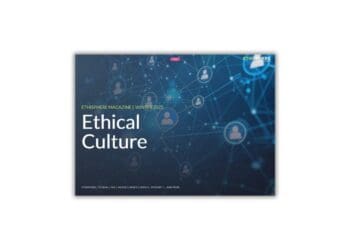Retaliation against whistleblowers is spiking. Employees and managers are feeling increased pressure across the board. Yet many ethics programs and cultures remain strong. CCI reached Patricia Harned, CEO of ECI, to discuss the latest Global Business Ethics Survey.
The Ethics and Compliance Initiative (ECI) has tracked national and global trends in workplace conduct since 1994. It published its 16th iteration of its Global Business Ethics Survey (GBES) on March 8. (In previous years, ECI published its Global and National Business Ethics Survey as different titles. They are now incorporated into the same report.)
In many ways, 2020 brought about unprecedented changes. Those changes played out in ethics and compliance cultures around the world. The report documents a number of troubling trends. Employees and managers are feeling greater pressure at work. Many companies are experiencing organizational change, which tends to compromise ethics programs. And retaliation against whistleblowers shot through the roof.
It's here! The 2021 Global Business Ethics Survey® Report is available to download. This unprecedented report explores the top trends affecting E&C programs and organizations in 2021 against more than 20 years of benchmark data. Download the report today https://t.co/2Rm326GIsN pic.twitter.com/33URpj59xg
— E&C Initiative (@ECInitiative) March 10, 2021
Corporate Compliance Insights reached Patricia Harned, CEO of ECI, to discuss some of the survey’s findings.
Patricia Harned Discusses the Rise of Retaliation Against Whistleblowers and Other Emerging Trends in Ethics
CCI: What is the single-most striking trend you would identify from this year’s report?
Patricia Harned: Without question, the findings related to retaliation against whistleblowers caught our attention at the ECI. Quite a while ago in this research, we found that retaliation is a very important indicator – not only for its influence on future reporting, but also because it impacts culture strength in an organization. We always hope that the numbers related to retaliation will remain low. But this year, nearly eight in 10 employees in the U.S. who reported misconduct said that they experienced retaliation for having done so. This was a 44 percent increase over the last measurement in 2017. While the global median was lower, at 61 percent, it too rose 46 percent over levels in 2017.
Do you think this spike in retaliation against whistleblowers can be traced to the coronavirus pandemic? Or are there other forces and dynamics at work?
COVID-19 could be playing a role, but there are likely other factors at work. In prior GBES reports, ECI has found that there is a relationship between reporting and retaliation. When reporting rises, so does retaliation. The same held true this year. We saw a substantial increase in reporting (20 percent), and we saw an even higher increase in retaliation. It is also possible that employees are more aware of what constitutes retaliation, and that leads more people to answer “yes” when asked about the outcome of their reporting process.
The coronavirus epidemic was no doubt the most significant driver of change in 2020. As the report states, ethics and compliance practices are most likely to be compromised during a period of organizational change. One trend in particular appears on its face to have direct ties to COVID-19: the vastly increased pressure to compromise standards (or “bend the rules”). But on the other hand, the report indicates that respondents for the most part did not associate misconduct with COVID-19. (About one-third said misconduct remained steady, 23 percent said it dropped and only 9 percent said it increased as a result of the pandemic.) Do you suspect there are other forces at work driving this surge in pressure to bend the rules? And/or is there more nuance regarding the pressures associated with COVID-19 than meets the eye?
Employees indicated in the survey that the onset of COVID did dramatically impact the amount of pressure they feel; however, that did not necessarily mean pressure to compromise standards in order to do their jobs. Rather, employees felt more pressure to meet performance goals, to be available and show value at work and also to keep their jobs. Pressure to compromise standards is more likely linked to business objectives and the influence of management on employees. In other words, it is more closely linked to the culture of an organization. While it is likely that some employees may be feeling pressure to cut corners if the economic situation puts their job in jeopardy, we did not find sufficient evidence in the data this year to demonstrate that definitively.
One thing I love about the GBES is that it highlights just how varied E&C cultures are around the world. My favorite comparison is that between India and Russia – two countries that make for interesting comparisons along economic, demographic and cultural lines outside of ethics and compliance. The GBES reports that professionals in India are most likely to report misconduct they witness – and also most likely to experience retaliation. In Russia, meanwhile, professionals are least likely to report misconduct but also least likely to experience retaliation. One might assume that, in a given E&C culture, the more likely one is to report misconduct, the less likely it is that whistleblowers experience retaliation. The lower the retaliation, the lower the stakes are for reporting. But considering the comparison between India and Russia, is that calculus skewed? Are there other factors that should be considered?
We love that about GBES, too! You are correct that there are some countries that experienced an increase in reporting and a reduction in retaliation, which is an encouraging sign. However, there were also a number of countries where the more traditional pattern appeared – as reporting increased, so too did retaliation. It is possible that in the countries where the pattern diverged, it is because E&C programs are doing a good job of encouraging reporting, hence the increase. Meanwhile, retaliation rates are likely still rising because it is one of the most difficult types of misconduct for organizations to address. It simply takes time.
The introduction of the report identifies a correlation between the strength of E&C culture at an organization and the quality of its E&C program. One might reasonably expect this to be the case. But I wonder: Is there causation at work here? Does a high-quality E&C program bring about a strong E&C culture? Or is the opposite true? Or is this more a case of the chicken and the egg?
What we have found is that the more an organization does to implement a high-quality ethics and compliance program, the greater the likelihood that employees will say that they work in a strong ethical culture. In fact, employees are 546 percent more likely to say that when they work in an organization with a high-quality E&C program, compared to 0 percent of employees who work in a weak culture. Quantitatively proving causation is a difficult thing to do, but in all likelihood, it appears that the program comes first.
That said, we can all probably think of organizations that have had strong cultures and haven’t done much in ethics and compliance. But that is not the norm. In past GBES studies, we found that 99 percent of organizations with strong cultures also have effective E&C programs in place.
The 2021 GBES identifies many dynamic changes that are occurring in the world. But I have to say, the most striking trend in my opinion is a plateau, not a spike. It is the plateau of perceived misconduct in the workplace which, all things considered, has remained remarkably steady (not varying more than 6 percent since the ECI began tracking it in 2000. Am I wrong in thinking that observed misconduct in the workplace is the ultimate bottom-line metric in your report? And considering how steady it has remained, do the current methods employed by E&C programs actually work at all?
Your observation is a good one. One you look at the rates of misconduct over the history of GBES, the numbers haven’t changed all that dramatically. In 2000 (when we first started measuring observed misconduct), 51 percent of employees said that they had observed something that constituted a violation of their organization’s standards or the law over the past year. This year, 49 percent of employees of employees said the same.
When we first started the GBES series, we considered misconduct to be the bottom-line metric, in part because we figured that is the problem that is most important for an organization to improve. However, the longer we have done the research, the more we have realized that misconduct is not the only important indicator of risk for an organization. Pressure to compromise standards and retaliation are also critical measures.
It is actually good news that misconduct hasn’t increased, as we know from the GBES research that misconduct is influenced by culture, and culture is influenced by the presence of an E&C program. So if anything, the data is showing us that E&C programs are having an impact. We just need to do more.



 Henry Kronk is the former Managing Editor of Corporate Compliance Insights. His previous reporting has appeared in Exclaim!, the Burlington Free Press, International DJ, eLearning Inside and more. He produced the radio show Code Burst — an investigation into a coding bootcamp that sought to retrain out-of-work coal miners for jobs in tech — for CKUT 90.3 FM in Montreal.
Henry Kronk is the former Managing Editor of Corporate Compliance Insights. His previous reporting has appeared in Exclaim!, the Burlington Free Press, International DJ, eLearning Inside and more. He produced the radio show Code Burst — an investigation into a coding bootcamp that sought to retrain out-of-work coal miners for jobs in tech — for CKUT 90.3 FM in Montreal. 








